With the end of the year approaching, Practical Sailor editorsoffer the annual selection of Editors Choice products for the Gear of the Year lineup. The 2010 roster covers a broad spectrum-from gadgets for measuring speed to boats built for speed-that have bested their peers in our tests. We hope the list, chosen from the dozens of all-star products evaluated in the November 2009 to July 2010 issues, will guide you through the dizzying array of gear at the fall boat shows, or at least help you whittle down your wishlist for Santa.
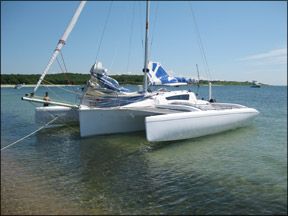
photo courtesy of Corsair International
Go-Fast Multihulls
Corsair Dash 750:
The 24-foot Dash 750 was featured in an article that profiled several different go-fast multihulls, ranging from beach cats like the Hobie Getaway, Weta, and the Windrider Rave to small coastal cruising tris like Performance Cruisings Telstar 28. The Dash was our top choice over the other multis we reviewed because not only does it deliver double-digits speeds in 12 to 14 knots of breeze, but its basic accommodations and trailerability make it a three-hulled pocket cruiser that can be enjoyed by the whole family. That versatility comes with a pricetag though: The Dash, at $57,000, was one of the most expensive boats reviewed.
The Dash is a plumb-bowed speedster with a retractable sprit, rudder, and daggerboard that keeps beachability an option while still harnessing the full-throttle performance in a pocket cruiser. The rotating wing mast sports a good-sized mainsail, and the jib, plus a sprit-mounted roller-furling reacher, make the sailplan quite versatile.

The Dashs accommodations are adequate for those out for a weekend or a coastal cruise, but will seem cramped to sailors looking for a cruising multihull like the Lagoon. However, the primary design criterion behind these boats is to unleash easy-to-handle performance, and Corsair met that goal admirably.
Bosun Chair
Brion Toss Climbing Harnesses:
Tosss Cruisers Harness uses all stainless-steel hardware, while the Regular Harness uses a high-grade cast alloy. In either case, youre getting the mother of all bosun chairs. We tapped them as our Best Choice over other quality gear, including chairs and mastclimbers from ATN, Black Diamond, Harken, and Spinlock.
A well-engineered design, a variety of useful extras, and rugged construction put Tosss harnesses at the head of the pack, and their prices reflect that: $400-$484. If youre a full-time cruiser, then it may be worth paying the extra $84 for the cruising harness with stainless hardware.
Testers also liked the less expensive Harken chair, which would be a good choice for those who put comfort as the highest priority, and the Spinlock, a more affordable harness for emergency trips to the mast while at sea.
Varnish Alternatives
Interlux Sikkens Cetol:
The all-star varnish alternative at the one-year mark in our long-term exposure test of more than 50 exterior wood finishes is Interluxs line of Sikkens Cetol products. Of the original 17 varnish alternatives, teak oils, and teak sealers tested, 12 made it to the one-year checkup (December 2009), and most of those were the two-step systems like Cetol that included a clear gloss overcoat.
The Cetol panels, for the most part, were still going strong after 12 months, outlasting similar coatings from TeaQua, Epifanes, Deks Olje, Le Tonkinois, and West Marine. The test panels coated with Interlux Sikkens Cetol Marine and a gloss topcoat and Marine Light with a gloss overcoat both rated very well. The coating integrity was flawless and the gloss unchanged; however, these finishes initially were “muddy” and have retained that quality.
Liking Cetols cloudy finish is subjective, but when it comes to single-application longevity, the Cetol Marine and Marine Light with gloss reign supreme among varnish alternatives.
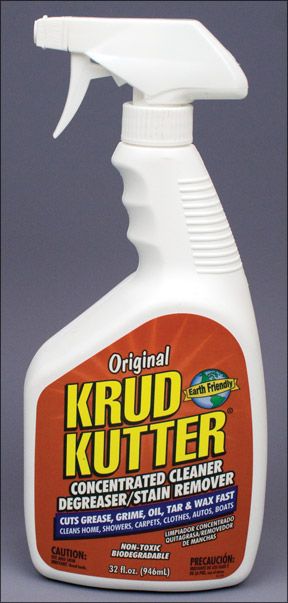
Dinghy paint
Polymarine Flexithane and Superflex
Beating out products from Synergy Research Corp. (Tuff Coat), Marine Development Research (MDR)-Amazon, and Flexdel were two products made by UK-based Polymarine.
Polymarine offers two different paints for inflatable boat restoration. Its Flexithane is specifically designed for Hypalon, and Superflex is for PVC fabrics. Both Polymarine paints produced a nice, smooth satin finish, rated Excellent for abrasion resistance, and passed adhesion testing. Both also beaded water after 30 days of exposure to the Florida sun and rain.
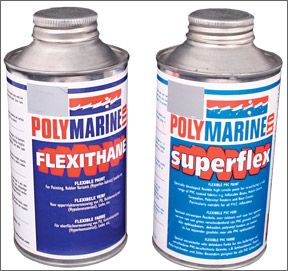
The downside of the Flexithane is its price: $93 for just more than a half-quart, which is about double the most expensive of the other test products. The Superflex costs about $36 for just more than a half-quart.
Stay tuned to see whether these products maintain their Editors Choice status when it comes to durability.
Degreaser
Krud Kutter:
The products faced grease-smeared fiberglass and a diesel engine caked with hard, thick soot. A second test on the diesel yielded two clear winners: Krud Kutter Degreaser/Stain Remover and Mary Kate Grease Away Engine Degreaser.

Photo courtesy of Seldén Mast
The Mary Kate Grease Away Engine Degreaser costs about $1.50 more than the Krud Kutter Degreaser/Stain Remover (19 cents per ounce), giving Krud Kutter the Editors Choice honors.
Headsail Furlers
Seldn Furlex 200S:
When it comes to all-weather easy furling, the units with efficient ball bearings won out, and Seldn Masts Furlex 200S got the PS pick for Best Choice. The Furlex topped a field of quality products from Alado, Cruising Design Inc., Reefurl, Spin-Tec, Harken Inc., Schaefer Marine, Facnor, and US Spars.
The 200S was the only test furler that came with a new headstay wire complete with turnbuckle, toggle, and the recommended Sta-Loc compression fitting. The Furlex stood out for its investment cast stainless hub and bearings, which were at the heart of its twist technology and made the furler one of the slickest spinners tested. The patented halyard swivel “load distributor” spreads the load over many balls to reduce point loading and friction. The foil sections are double slotted and elliptical in shape, and the full-turn tack swivel allows the mid portion of the sail to lead off in the furling/reefing process.

With a price tag of nearly $3,000, the Furlex was one of the more expensive furlers tested; the others ranged in cost from $525 to $3,200.
Picking a furler winner was difficult due to the refinements most of these products have gone through and an obvious across-the-board increase in quality. But in the end, sound engineering and the reliability of an investment cast stainless hub assembly and bearings gave the extra nudge to the Furlex.
Cam Cleat
Spinlock PXR:
Doomsday is a contraption PS testers built to put cam cleats through their paces-1,000 load cycles of pull, hold, and release on a length of New England Ropes 3/8-inch Sta-set-as we looked for one that was fairly easy on the line and on the user. The test victims included cleats from Harken Inc., Seldn Mast, Ronstan Marine, Garhauer Marine, Schaefer Marine, and Spinlock.
At the head of the class was the Spinlock PXR…actually, the PXR is in a class of its own. Against Doomsday, it produced a barely noticeable neck and no fuzz on the test line after 1,000 cycles, making it the kindest cleat tested. And unlike the more conventional cams, the Spinlock has a fixed line-entry lead on the bottom and a pivoting exit lead on the top. The top cam releases completely when the tail of the line is lifted to pivot the exit lead upward and re-engages when the tail is pulled downward to flip the exit lead down. You can also operate the release by stepping on the top of the body.
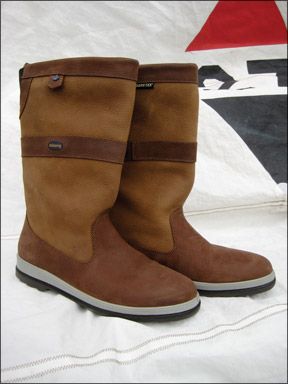
Photo by David Liscio
The PXR accomplishes several auxiliary tasks that would require add-ons with the other cam cleats tested. While its not an exact replacement for a “standard” cam cleat, the fact it can be released under load and the line is always in control is a big bonus. With a carbon fiber-reinforced composite body and aluminum cams, the PXRs safe working load is rated at 440 pounds and its breaking load 880 pounds.
The downside is that its price ($53) is also in a league of its own compared to the other top performers in the test, which ranged from $18-$32.
Sea Boots
Dubarry Ultima:
Topping the 15-boot field in the October 2009 test was the Dubarry Ultima model, which notched Excellent performance ratings in grip, comfort, and waterproofness. The boots feature high-performance, soft brown leather treated to repel water and dry fast. They are not insulated, but their Gore-Tex lining wicks away perspiration and is woven tightly to be waterproof. The three-quarter boots have a honeycomb sole that proved very effective during traction tests.
The Ultimas were favored over designs from Aigle, Gill, Helly Hansen, Puma, Sperry, Ronstan, West Marine, and Musto.
For most of us, the Ultimas $345 pricetag is a hard pill to swallow, but we consider it an investment in comfort and safety for a top-of-the line pair of sea boots.
Womens Sailing Sandals
Keen Venice H2:Boat decks are mazes of toe-stubbing hardware and slippery surfaces, making foot protection a key component to a sailors kit. When temperatures soar and sea boots become too hot to bear, sailing sandals fit the bill.

photo courtesy of Corsair International
1)]
We tested eight womens sailing sandal designs in the July 2010 issue, and tapped the Keen Venice H2 as our Editors Choice for its excellent performance in traction testing, its comfortable fit-wet or dry-and its excellent foot protection thanks to a large toe bumper and adjustable fit. We also tested designs from Teva, Columbia Sportswear, and Sperry Top-Sider.
The Venice H2 shoes have compression-molded EVA midsoles and footbeds. They have washable, polyester webbing uppers that can be adjusted with an elastic cord and plastic toggle lacing system for a comfortable and secure fit.
At $95, they are a bit pricier than others we tested, but the shoes open strapping system allows for plenty of ventilation, and its grippy, non-marking outsole uses multi-directional lugs that rated among the best for traction.
Inverter-charger
Mastervolt Combi 12/200-100:

photo courtesy of Corsair International
2)]
The Mastervolt Combi 12/200 was the lightest unit tested, and it was also one of the quietest in terms of EMI and RFI emissions. At $2,599, it was the second most expensive in our test group, but that includes the remote panel, temperature sensor, and its handy paralleling capabilities in inverter mode.
For those with larger AGM or gel-cell batteries onboard who are planning to expand their systems down the road, we would definitely recommend the Mastervolt Combi 12/100. It offers a high level of sophistication in terms of charger calibration and output for a reasonably large bank of batteries. On the inverter side, its clean, pure-sine wave output and low noise make it a winner for high-level audio and video power supply systems. Also, as the boats systems grow, an additional unit can be easily piggy-backed on to double the power capacity.
The Mastervolt beat out products from Charles Industries, Magnum Energy, ProMariner, Tripp Lite, and Xantrex for the top spot.
LED Nav lights
Lopolight and Lunasea:

photo courtesy of Corsair International
3)]
The Lopolight is a well-designed, and carefully manufactured LED tri-color/anchor light. In addition to adding redundancy with circuitry that allows individual diodes to fail without taking out the entire cluster, the design eliminates the hotspot inherent in tri-color lights that use single-point light sources for each sector. The Lopolight also sports a rugged, well-sealed housing thats fully submersible.
At $689, the Lopolight was the most expensive product of all those we tested, but it also had the least RFI, quality construction, and superior performance.
For those who already have a sound, well-sealed Aqua Signal 40 tri-color masthead light or equivalent with a current-hungry incandescent bulb in place, upgrade to a Lunasea, a well-sealed, wedge shaped, waterproof bulb that uses separate LEDs for each color zone. The Lunasea ($71) was pricier than the other test bulbs ($20-$50), but it also was the only one in its group with the ability to keep shining even if one of the multiple diodes failed and the only one that offers a lifetime warranty.
When it comes to navigation lights aboard sailboats, brighter is definitely better. And our latest test of LED tri-color nav lights (March 2010) proved that more light can be made with less energy. The energy-misers that impressed testers enough to land a spot on the Gear of the Year list were the Lopolight 200-005 tri-color lantern and the Lunasea 25NT-24-00, a replacement for incandescent bulbs. Overall, the two out-performed their counterparts from Orca Green Marine (OGM), Signal Mate, LED Shop, and Dr. LED. In the last five years, battery chargers have gotten smarter as charging-regimen algorithms have gotten more precise. The February and March 2010 issues took a look at the latest “smart” inverter-charger combinations. The most sophisticated among them was the Mastervolt Combi 12/200-100, which earned its spot on the 2010 Gear of the Year roster for its flawless performance in tests. Effective foul-weather gear keeps you warm, dry, and able to face whatever Mother Nature has in her arsenal. And at the base of it all-literally-are quality sea boots.
In the May 2010 issue, eight cam cleats from six manufacturers faced Doomsday. Engineering advances have improved roller-furling systems, and the latest units show some promising new innovations. In late 2009, Practical Sailor tested 11 headsail furlers with head swivels (August 2009) and without (September 2009) for 30- to 35-foot sailboats. After several rounds of testing liquid spray degreasers to narrow the 11-product test field, Krud Kutter Degreaser/Stain Remover edged out Mary Kate Grease Away Engine Degreaser for our top pick. Both products performed better than degreaser-cleaners from Star brite, Chomp, Spray Nine, MDR, T-Greaser, Kafko, Simple Green, and others. : In “Tender Lovin for Aging Dinks” in the June 2010 issue, testers evaluated paints marketed as flexible coatings to restore and revitalize the topsides of inflatable boats that have seen too many sunsets. The report, which launched our long-term durability test, focused on the dinghy paints application, abrasion resistance, and adhesion.

photo courtesy of Corsair International
0)]
While the fat lady hasn’t sung on this test just yet, we did choose a top pick based on the initial findings. When it comes to wood finishes, picking the perfect product rests on weighing pros and cons to see which one best matches your needs. For those who seek the middle ground for ease of application, maintenance, durability, and aesthetics, synthetic teak treatments are the way to go. They don’t have the mirror-like, classic look of a hard varnish or the durability, but they require about 75 percent less labor to apply and maintain.
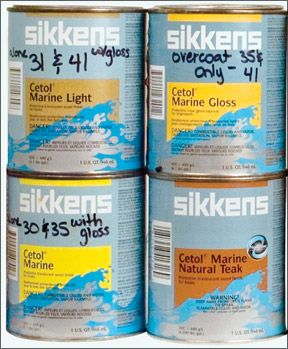
Working aloft typically involves some pretty awkward positions, and having a bosun chair or climbing harness that you feel comfortable and secure in is key when youre trying to make masthead fixes in a rolling seaway. In our June 2010 test of the devices, two products stood above the rest, scoring nearly perfect 10s for comfort and security: the Regular and the Cruisers harnesses made by Brion Toss. Toss is a professional rigger based in Port Townsend, Wash., who has built a loyal following among sailors through his seminars, videos, and book, “The Complete Riggers Apprentice.”
In the May 2010 issue, we turned our attention to the slick-bottomed, performance multihull market to find a practical boat that would satiate those adrenaline-hungry sailors, and we found one: The Corsair Dash 750.






































